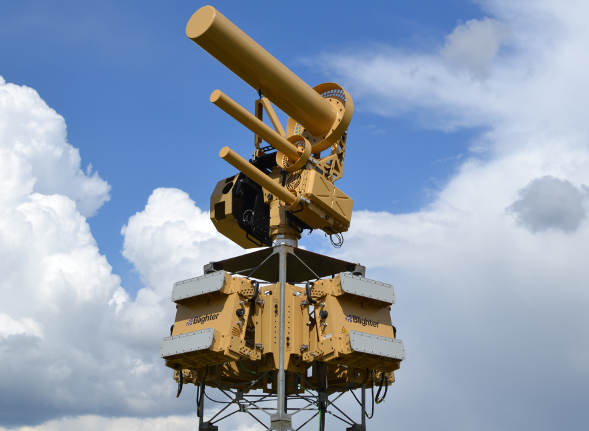The Anti-UAV Defence System (AUDS) is the product of three different British companies: Blighter Surveillance Systems, Chess Dynamics, and Enterprise Control Systems. The capability is designed to detect, track and interfere with UAVs that are engaged in potentially malicious activity. Robotics Law Journal spoke to Chess Dynamics about AUDS and what it will mean for the future of drone use.
The malicious use of drones has been rising, with high pro le breaches of security at the White House and the high number of incursions over nuclear power stations, especially in France. Equally, there has also been a rise in announcements of anti-drone technology being implemented, such as at Euro 2016, re ecting the newly emerging potential threat. The necessity for a speci c technology like this came about due to airspace violations over the DMZ between North and South Korea, whereby North Korean drones, whilst being detected, could not be combatted. This was the genesis of AUDS.
There are three parts to this system. First, the Blighter radars will detect a UAV in a designated target area, regardless of weather conditions. Once acquired, the target is handed over to the Chess Dynamics Hawkeye Deployable System, which uses both thermal and daylight cameras. The UAV is tracked, identified and classified. The human operator will then able to make the decision early, using all the information gathered from the radar and the EO tracker, to use the Enterprise Control Systems inhibitors to interfere with the C2 channels on the UAV in order to disrupt it, keeping collateral damage to a minimum.
Collaboration
None of the three companies could have created this technology on their own, they were all able to identify and recognise their skill sets and how they could complement each other. Collaboration has brought about this unparalleled success and in the quickest possible time – it took just a few months to create a prototype from the three CEOs originally putting their heads together. As with a lot of technologies, getting in early counts for a lot and the speed this collaboration has afforded them has been a real advantage.
Regulations
With AUDS, the interference stage involves radiating electronically, which requires the operator to have a licence. For all types of electronic radiation, particularly in controlled bands, the operator needs a licence. This is a pre-existing regulation that applies to those who would wish to operate AUDS, and helps to ensure that it can’t be used by just anyone wanting to survey the area around their house, for instance. The prevention of intentional malicious use or accidental misuse of both drones and any countermeasure, that could cause collateral damage in some way, is the main aim of such regulation.
Unsurprisingly therefore, the client base is restricted, at present, to national and international government departments. The UK has some of the strictest export control legislation in the world. With technology like this it is important that the Ministry
of Defence and the other government departments that are part of the Export Control Organisation (ECO) know who the potential customers and users are, and they need to be shown to be responsible upstanding people. Most applications to international government departments from friendly countries have been successful and no warning ags have been raised within ECO.
If an unscrupulous company or person was interested in acquiring this technology to enhance their own security, they would have to go through a very stringent vetting process. It is a test of the individuals’ or organisations’ trustworthiness and character that determine whether or not the UK Government will licence the sale. This is both necessary to avoid the danger of the technology getting into the wrong hands (3rd party exploitation), but also to protect IP.
Could it be sold commercially in the future? Technically it could, but there would have to be close oversight by governmental departments. If an energy company wanted to protect its power stations and could make a strong case for acquiring this technology (the protection of critical national infrastructure), they would charge their security contractor for updating the security perimeters who would then become a buyer of the AUDS. That contractor would naturally be licensed themselves by the government to buy and operate it.
The future will undoubtedly hold some commercial aspect for this technology. Much like UAVs themselves, it began life as a military technology, became miniaturised and moved to being developed commercially. Future regulation would have
to deal with a greater potential for misuse, the same way that drone regulation is hitting those same barriers at present. For
the moment, the regulation complements the use of this technology on the governmental level and doesn’t hold any serious barriers because it is not yet being sold commercially.
So the regulation rests primarily with the licensing structure and presently this is very much restricted to government departments. Should commercial operators be delegated the responsibility for using this technology, they would have to ensure that only approved people are the ones that are using it. Great care has to be given on who it is demonstrated to and who it is likely to be sold to.
US interest
The US is the single biggest technology market in the world. While they like to protect their own industries, they are equally happy to go abroad if they lack an ability to produce a particular capability on their own. The wide range of scenarios that AUDS can be used in is its major selling point. The threat from drones is global in this regard, and is the same regardless of whether an operation is military or civilian. AUDS and its parent companies were looked at closely by US authorities before being invited for trials. AUDS’ US distributor, Liteye Systems, has been successful in promoting the capability in the US which has led to the FAA shortlisting the technology for evaluation at a number of US airports within its Pathfinder system.


.jpg)
.jpg)
.jpg)

.jpg)



.jpg)
